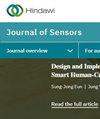Research on the Factors Influencing the Seismic Performance of Grouting Sleeve Assembled Double-Column Piers
IF 1.1
4区 工程技术
Q3 ENGINEERING, ELECTRICAL & ELECTRONIC
引用次数: 0
Abstract
The present study investigated the influence of key design parameters on the seismic performance of prefabricated precast assembled piers’ connection parts to better adapt to the industrialized construction of prefabricated precast assembled pier connected using grouting sleeves. Relying on a prefabricated assembled bridge in the actual project, the ABAQUS software was used to establish a refined solid finite element model of prefabricated assembled piers connected with grouting sleeves. Numerical simulation analysis was conducted for the piers with low circumferential reciprocating loading. The seismic performance of the prefabricated assembled piers was evaluated in terms of hysteresis characteristics, dissipation characteristics, and damage development. The effects of the length of the grouting sleeve and the diameter of the longitudinal reinforcement on the seismic performance were also investigated. The maximum error between the numerical simulation results and the test results was 5.7%, and the plastic region of the precast assembled pier obtained from the numerical simulation was consistent with the test results, indicating that the numerical simulation method is accurate and reliable. When the length of the grouting sleeve increased from 0.6 to 1.2 m, the yield load, peak load, and dissipation of energy of prefabricated assembled piers increased by 11.6%, 10.9%, and 11.4%, respectively; no significant change in residual displacement; ductility coefficient decreased by a small amount. When the longitudinal reinforcement diameter increased from 20 to 50 mm, prefabricated assembled piers yield load, peak load, and dissipation increased by 99.6%, 89.3%, and 218.9%, respectively, whereas the residual displacement increased by 137.3%, and the ductility coefficient decreased more. Increasing the length of the grouting sleeve or increasing the diameter of longitudinal reinforcement improved the stiffness of the piers, causing the piers to displace less and damage less under the same force, but the residual displacement would increase.灌浆套筒装配式双柱墩抗震性能影响因素研究
本研究探讨了关键设计参数对预制装配式墩台连接部位抗震性能的影响,以更好地适应采用灌浆套筒连接预制装配式墩台的工业化施工。依托实际工程中的预制装配式桥梁,采用 ABAQUS 软件建立了灌浆套筒连接预制装配式桥墩的实体有限元精化模型。在低圆周往复荷载作用下,对桥墩进行了数值模拟分析。从滞后特性、耗散特性和损伤发展等方面评估了预制装配式桥墩的抗震性能。此外,还研究了灌浆套筒长度和纵向钢筋直径对抗震性能的影响。数值模拟结果与试验结果的最大误差为 5.7%,数值模拟得到的预制装配式桥墩塑性区与试验结果一致,表明数值模拟方法准确可靠。当灌浆套筒长度由 0.6 m 增加到 1.2 m 时,预制装配式桥墩的屈服荷载、峰值荷载和耗能分别增加了 11.6%、10.9% 和 11.4%;残余位移无明显变化;延性系数有少量下降。当纵向钢筋直径从 20 mm 增加到 50 mm 时,预制装配式桥墩的屈服荷载、峰值荷载和耗散分别增加了 99.6%、89.3% 和 218.9%,而残余位移增加了 137.3%,延性系数下降较多。增加灌浆套筒的长度或增大纵向钢筋的直径可提高桥墩的刚度,使桥墩在相同的力作用下位移更小,破坏更小,但残余位移会增加。
本文章由计算机程序翻译,如有差异,请以英文原文为准。
求助全文
约1分钟内获得全文
求助全文
来源期刊

Journal of Sensors
ENGINEERING, ELECTRICAL & ELECTRONIC-INSTRUMENTS & INSTRUMENTATION
CiteScore
4.10
自引率
5.30%
发文量
833
审稿时长
18 weeks
期刊介绍:
Journal of Sensors publishes papers related to all aspects of sensors, from their theory and design, to the applications of complete sensing devices. All classes of sensor are covered, including acoustic, biological, chemical, electronic, electromagnetic (including optical), mechanical, proximity, and thermal. Submissions relating to wearable, implantable, and remote sensing devices are encouraged.
Envisaged applications include, but are not limited to:
-Medical, healthcare, and lifestyle monitoring
-Environmental and atmospheric monitoring
-Sensing for engineering, manufacturing and processing industries
-Transportation, navigation, and geolocation
-Vision, perception, and sensing for robots and UAVs
The journal welcomes articles that, as well as the sensor technology itself, consider the practical aspects of modern sensor implementation, such as networking, communications, signal processing, and data management.
As well as original research, the Journal of Sensors also publishes focused review articles that examine the state of the art, identify emerging trends, and suggest future directions for developing fields.
 求助内容:
求助内容: 应助结果提醒方式:
应助结果提醒方式:


